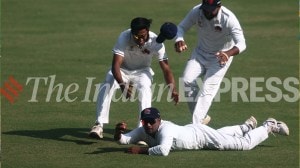Red Eye, Blue Eye
When a person is photographed, the result can often be a ‘‘red eye’’, but when some animals, a dog for instance, get clicked, the photo usually shows ‘‘blue eye’’. Why?

When a person is photographed, the result can often be a ‘‘red eye’’, but when some animals, a dog for instance, get clicked, the photo usually shows ‘‘blue eye’’. Why? The difference lies in the layers of cells at the back of the eyeball, where the flash of light strikes. When people are photographed in dim light, their pupils are wide open to let in enough light to see. As the flash hits the retina, which is richly supplied with blood vessels that are close to the surface, a red reflection may result. In most dogs, and in most cats as well, there is a reflective layer beneath the light receptors of the retina called the tapetum lucidum, Latin for bright carpet. This mirror helps the animals maximise their seeing ability in dim light by reflecting any light not absorbed during its first passage through the retina back for a second opportunity to be absorbed. The colour of the tapetum varies, and with it the color that is reflected back to the camera, but for most adult dogs the resulting flash is blue or green. Blue-eyed dogs and cats may lack pigment in this layer, and so huskies and Siamese cats often show red eyes in photos. Puppies and kittens are also likely to show red eyes because their eye structures have not finished developing.
Problem: Salt sticks in the shaker. Solution: Make it roll.
Here is something to take with a grain of salt—if it doesn’t roll away from you. Scientists have made salt granules that are almost round. That might help at mealtime. ‘‘I am sure everyone has experienced the annoyance with table salt which does not come out of the salt shaker,’’ said Pushpito K. Ghosh, a researcher at the Central Salt and Marine Chemicals Research Institute in Bhavnagar, India. Table salt is sodium chloride, and because the atoms of sodium and chloride stack up in a cubic pattern, salt crystals are generally cubic in shape. The flat surfaces of a cube make it easy for the crystals stick to one another, especially when the air is humid. And that clumping keeps salt from shaking out of saltshakers. Chemistry offers a solution. A half-century ago, scientists found that adding the amino acid glycine to a salty brine solution slows the growth around the edges of a cubic crystal. The crystal grows not into a cube but into a 12-sided, almost spherical shape known as a rhombic dodecahedron. Round salt, not surprisingly, flows more easily and is less likely to stick together. In research scheduled to appear in the July 5 issue of the journal Crystal Growth & Design, Ghosh and colleagues report that adding a step to wash the newly formed crystals in a new batch of brine could make the process practical for mass production. The salt, Ghosh said, tastes like salt, no matter what shape it is. (NYT)
When Birds Burn More Energy
In animal species that produce multiple offspring, there is usually a trade-off between quantity and quality. The more offspring one has, particularly at one time, the more likely that some of them, at least, will be less fit. Competition for food during development is the usual culprit. But can the number of offspring affect fitness over the long term, into adulthood? That is what Simon Verhulst of the University of Groningen in the Netherlands and colleagues wanted to find out.
They studied zebra finches, manipulating brood size so that some chicks were raised with one or two others and some in broods of five or six. Thirteen months later, the birds’ metabolic rate was measured. The findings were published last week in Biology Letters. The researchers discovered that independent of mass, birds raised in larger broods had a metabolic rate about 9 percent higher than that of birds from smaller broods. The effect was more pronounced in females than males. The finding is in line with other studies that have shown that zebra finches raised in large broods tend to have shorter lifespans, with females dying sooner than males. The current study only infers a connection between higher metabolic rate and longevity. But such a link makes sense. A higher metabolic rate means that birds have to spend more time foraging and may be more affected by fluctuations in the food supply or by climatic conditions that increase energy needs. Life is tougher for a bird that burns energy faster. Regardless of a connection, though, the study shows that the conditions under which rearing occurs can have long-term effects on fitness. (NYT)




- 01
- 02
- 03
- 04
- 05



























